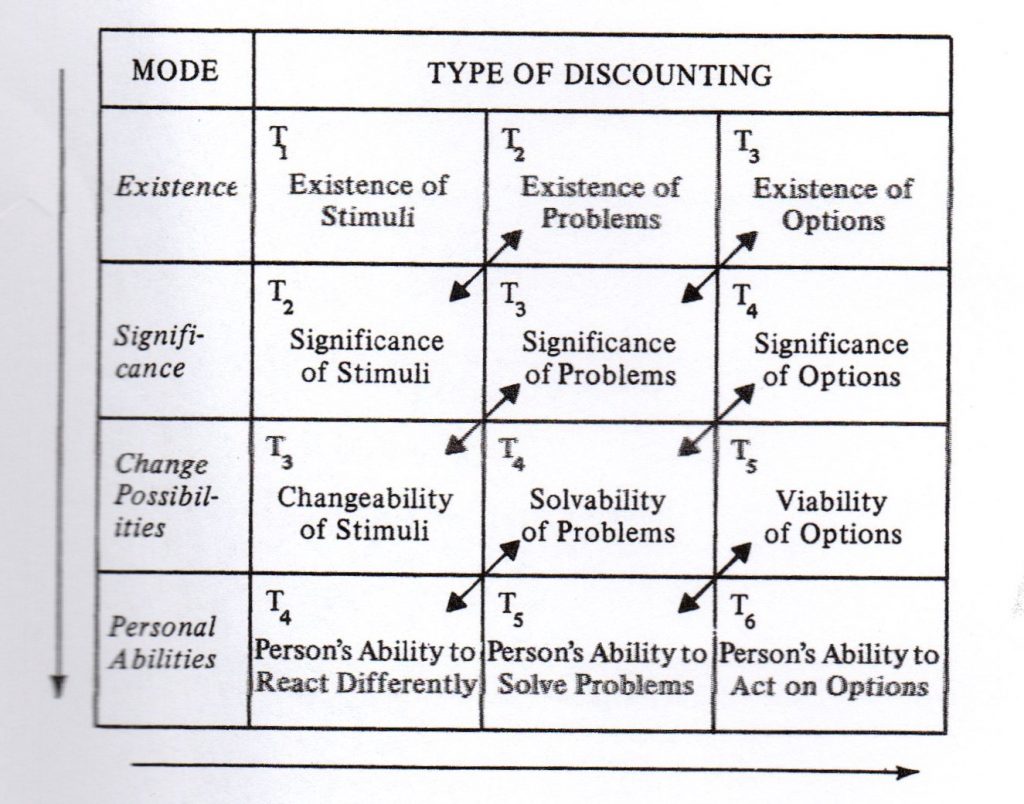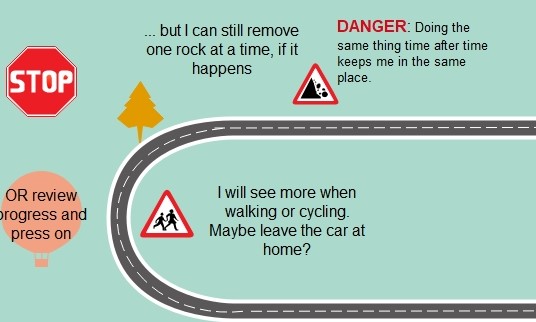Pretty well never I would say, but I would, wouldn’t I! So let me explain myself more by describing The Ripple Effect.
To say even more, I want to return to the Discount Matrix. This is a tool you can use to monitor safe experiments and cast some light when changes you want seem not to emerge? It’s a tool that highlights how safe experiments can be difficult, and what makes them so.
The Matrix can offer us a different focus for our attention. It may tell you and me when to take a rest from safe experiments. That is especially so when I am trying too hard!! If I ‘try’ too hard then it is easy to miss what might be done next. I can’t see the wood for all the trees. Sometimes we think we’ve done all we can, and there is little else to be acheived.
BUT another conclusion might: I still need time to reflect – there is something troubling me, and I cannot put a finger on it.
Can it be that I am discounting something at the highest level on the Matrix and thinking and talking about it is not helping at this time. Being open to this possibility can mean that safe experiments will continue – perhaps in a more fruitful fashion. There is no necessity to these changes to arise within a therapaeutic relationship – with a professional.
I can continue to do safe experiments as they do not need to come to an end when therapy finishes.
Does the excerpt from the scenic route, above, show that there may be further corners to turn? I need a way of knowing whether to go on, to stop or to take a rest.
A review of progress can help us to assess our situation and make informed decisions. After a review, you may feel confident that you can safely experiment without consultation – and you will know where to go if the situation should change. You may be confident about the scenic route you are taking, and where to go next.
It may help, further, to read this information alongside this page:
- the Johari Window – to record your journey into the unknown from the better known, and
- Does This Make Any Sense – how have safe experiments widened your Window of Tolerance (WOT) and what might you do to widen it further?
- When action may not be enough.
- They are not really experiments are they!
Does it help to connect these pages to the Discount Matrix, pictured below?
For the record, the Matrix was used by Jacqui Lee Schiff (1975) and I want to use it on thsi page for a very specific purpose.

To fit this Matrix into the safe experiment, I will translate each the box, from top to bottom, using the symbols T1 to T4 above, as:
T1. You and I can do nothing until we recognise there is something to address.
T2. We can do little unless we judge that ‘something’ is significant or important to us.
T3. We can only begin to design experiments once we can see the possibility of change.
T4. We are experimenting effectively once we use our abilities to make changes and just notice the outcomes.
Level 1 is the trickiest; we do not know what we do not know. Remember the Johari Window. No experiment is possible until we realise it needs to be designed in the first place. By contrast, level 4 is the ‘easiest’ level to work on. Here, the design of safe experiments is within our grasp. We may be able to implement them and notice the results.
In practice, growing awareness increases in the Johari Window as we move from some awareness – upper left to lower right, the area of not knowing. The same applies with the Discount Matrix. Top left – difficult to be aware; bottom right – more able to be aware.
In other words, I will do nothing until a problem or issue is seen to exist. I will complete safe experiments once an issue is acknowledged. The best safe experiments are designed – and implemented when I have to ability to act on choices I have discerned.
I can make choices only after I have thought about things and made a judgement that something needs to change AND I can see how to go about it.
THE SAFE EXPERIMENT: How does this work in practice so you can make a judgment about the progress you are making? Get a piece of paper:
- From the work you have done so far: identify one issue you did not realise existed for you, but you do now. How did you help the issue come into existence – into your awareness?
- From your present assessment, can you imagine something that has yet to be done? This will be something on the edge of your awareness or at the outer edges of window of tolerance (WOT) – between the known, inside the window and toward the unknown – along that scenic route. If you find something – how significant is it in your life, now?
- What are the alternative ways of thinking about the change you might need to make? Perhaps a friend or partner can help you ‘brain storm’, that is, write down as many possibilities as you can without censoring anything as ‘silly’ or unreasonable. Sort out the reasonable and unreasonable only after the event.
- What is stopping you making the necessary change? What is it about your skilful and unskilful actions that appears to get in the way? What abilities can you now apply to make something happen?
The Discount Matrix allows us to organise our work in many ways and I cannot list them all here. Test it out further and see what you can find.
Some leads to follow
An illustrated route in nudging yourself
More on Transactional Analysis
